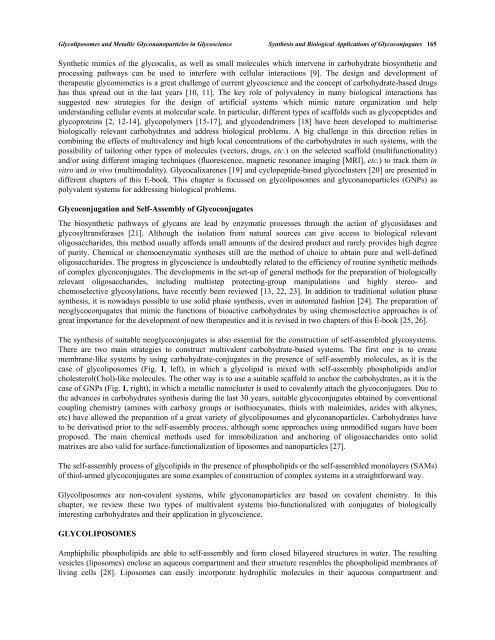chapter 2 - Bentham Science
chapter 2 - Bentham Science
chapter 2 - Bentham Science
Create successful ePaper yourself
Turn your PDF publications into a flip-book with our unique Google optimized e-Paper software.
Glycoliposomes and Metallic Glyconanoparticles in Glycoscience Synthesis and Biological Applications of Glycoconjugates 165<br />
Synthetic mimics of the glycocalix, as well as small molecules which intervene in carbohydrate biosynthetic and<br />
processing pathways can be used to interfere with cellular interactions [9]. The design and development of<br />
therapeutic glycomimetics is a great challenge of current glycoscience and the concept of carbohydrate-based drugs<br />
has thus spread out in the last years [10, 11]. The key role of polyvalency in many biological interactions has<br />
suggested new strategies for the design of artificial systems which mimic nature organization and help<br />
understanding cellular events at molecular scale. In particular, different types of scaffolds such as glycopeptides and<br />
glycoproteins [2, 12-14], glycopolymers [15-17], and glycodendrimers [18] have been developed to multimerise<br />
biologically relevant carbohydrates and address biological problems. A big challenge in this direction relies in<br />
combining the effects of multivalency and high local concentrations of the carbohydrates in such systems, with the<br />
possibility of tailoring other types of molecules (vectors, drugs, etc.) on the selected scaffold (multifunctionality)<br />
and/or using different imaging techniques (fluorescence, magnetic resonance imaging [MRI], etc.) to track them in<br />
vitro and in vivo (multimodality). Glycocalixarenes [19] and cyclopeptide-based glycoclusters [20] are presented in<br />
different <strong>chapter</strong>s of this E-book. This <strong>chapter</strong> is focussed on glycoliposomes and glyconanoparticles (GNPs) as<br />
polyvalent systems for addressing biological problems.<br />
Glycoconjugation and Self-Assembly of Glycoconjugates<br />
The biosynthetic pathways of glycans are lead by enzymatic processes through the action of glycosidases and<br />
glycosyltransferases [21]. Although the isolation from natural sources can give access to biological relevant<br />
oligosaccharides, this method usually affords small amounts of the desired product and rarely provides high degree<br />
of purity. Chemical or chemoenzymatic syntheses still are the method of choice to obtain pure and well-defined<br />
oligosaccharides. The progress in glycoscience is undoubtedly related to the efficiency of routine synthetic methods<br />
of complex glycoconjugates. The developments in the set-up of general methods for the preparation of biologically<br />
relevant oligosaccharides, including multistep protecting-group manipulations and highly stereo- and<br />
chemoselective glycosylations, have recently been reviewed [13, 22, 23]. In addition to traditional solution phase<br />
synthesis, it is nowadays possible to use solid phase synthesis, even in automated fashion [24]. The preparation of<br />
neoglycoconjugates that mimic the functions of bioactive carbohydrates by using chemoselective approaches is of<br />
great importance for the development of new therapeutics and it is revised in two <strong>chapter</strong>s of this E-book [25, 26].<br />
The synthesis of suitable neoglycoconjugates is also essential for the construction of self-assembled glycosystems.<br />
There are two main strategies to construct multivalent carbohydrate-based systems. The first one is to create<br />
membrane-like systems by using carbohydrate-conjugates in the presence of self-assembly molecules, as it is the<br />
case of glycoliposomes (Fig. 1, left), in which a glycolipid is mixed with self-assembly phospholipids and/or<br />
cholesterol(Chol)-like molecules. The other way is to use a suitable scaffold to anchor the carbohydrates, as it is the<br />
case of GNPs (Fig. 1, right), in which a metallic nanocluster is used to covalently attach the glycoconjugates. Due to<br />
the advances in carbohydrates synthesis during the last 30 years, suitable glycoconjugates obtained by conventional<br />
coupling chemistry (amines with carboxy groups or isothiocyanates, thiols with maleimides, azides with alkynes,<br />
etc) have allowed the preparation of a great variety of glycoliposomes and glyconanoparticles. Carbohydrates have<br />
to be derivatised prior to the self-assembly process, although some approaches using unmodified sugars have been<br />
proposed. The main chemical methods used for immobilization and anchoring of oligosaccharides onto solid<br />
matrixes are also valid for surface-functionalization of liposomes and nanoparticles [27].<br />
The self-assembly process of glycolipids in the presence of phospholipids or the self-assembled monolayers (SAMs)<br />
of thiol-armed glycoconjugates are some examples of construction of complex systems in a straightforward way.<br />
Glycoliposomes are non-covalent systems, while glyconanoparticles are based on covalent chemistry. In this<br />
<strong>chapter</strong>, we review these two types of multivalent systems bio-functionalized with conjugates of biologically<br />
interesting carbohydrates and their application in glycoscience.<br />
GLYCOLIPOSOMES<br />
Amphiphilic phospholipids are able to self-assembly and form closed bilayered structures in water. The resulting<br />
vesicles (liposomes) enclose an aqueous compartment and their structure resembles the phospholipid membranes of<br />
living cells [28]. Liposomes can easily incorporate hydrophilic molecules in their aqueous compartment and

















